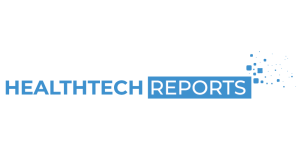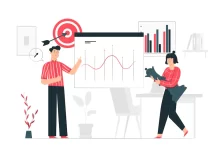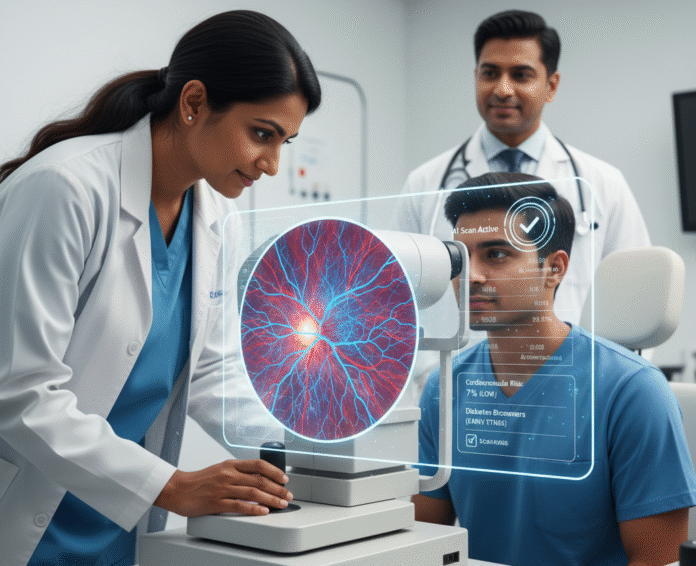The world of medical technology is getting a serious upgrade, and the biggest news is happening in the most unexpected place: your eye doctor’s chair.
It’s long been said that the eye is a “window to the soul,” but doctors know it’s really a window to the body. It’s the only place where we can directly see blood vessels, nerves, and tissues without cutting you open. Now, thanks to Artificial Intelligence (AI), this window is being thrown wide open, allowing us to find major hidden problems, like high blood sugar, undiagnosed diabetes, and even your risk for a heart attack, just by taking a quick picture of your retina.
This isn’t some far-off sci-fi dream. Advanced AI-powered systems are launching right now, ready to revolutionize how we screen for the two biggest killers worldwide: heart disease and diabetes. Getting a quick eye scan is about to become one of the fastest, safest, and smartest ways to get a deep health check.
Why Do We Need a New Way to Check Our Health?
Think about how we currently check for serious illnesses. To find diabetes, you need blood tests, often involving fasting. To gauge your heart disease risk, you get cholesterol checks, blood pressure readings, and maybe an EKG. These methods work, but they have major drawbacks:
- They’re slow and costly: Sending samples to labs and scheduling specialist appointments creates friction, especially in communities without easy access to big hospitals.
- They can be too late: Many people live with high blood sugar for years without knowing it. By the time they finally get a diagnosis, damage to their kidneys or nerves may already be permanent.
The sheer scale of these problems demands a simpler, faster tool. That’s where AI-Powered Retinal Screening comes in. It’s quick, painless, inexpensive, and can be done virtually anywhere.
How Does the AI See What We Miss?
The real magic is in the deep learning algorithms. These AI models are incredibly smart because they’ve been trained on millions of retinal images linked to detailed patient records, everything from blood pressure to actual heart attacks.
Where a human eye sees complex blood vessels, the AI sees patterns and data points that indicate systemic stress. It’s like having a hyper-trained expert scanning every inch of your microvasculature.
what the AI is looking for:
- Tiny Damage from Sugar: In the context of diabetes, the AI quickly spots microscopic damage like microaneurysms and bleeding. These are early warning signs of diabetic retinopathy, which directly signals long-term high blood sugar.
- Vessel Wear and Tear: For cardiovascular health, the AI looks at the thickness, shape, and winding pattern of your vessels. These subtle changes are essentially the same wear and tear that’s happening in the arteries supplying your heart and brain.
- A Direct Risk Score: The most advanced systems use these vascular patterns to calculate a patient’s actual 5 or 10-year risk of having a major event, like a stroke or heart attack. In many cases, these instant, non-invasive readings are as accurate as lengthy, traditional risk assessments.
The AI turns a simple eye photo into a full diagnostic report, giving doctors an unprecedented early look into a patient’s internal health.
A Game Changer for Healthcare Accessibility
One of the most exciting aspects of this health tech is its potential for scalability. Because the procedure is non-invasive and uses standard equipment, it drastically improves accessibility:
- Screening on Demand: You can move life-saving screening out of specialized hospitals and into local clinics, pharmacies, or even mobile screening units.
- Speed and Efficiency: Results are delivered instantly. There’s no waiting for a lab. This immediate feedback means patients can start treatment the same day.
- Lowering Costs: Since the bulk of the cost is in the initial software, the cost-per-scan drops dramatically, making it an affordable, high-volume tool for population health initiatives.
In short, AI-Powered Retinal Screening makes it easier and cheaper to check the health of an entire population, giving health systems a proactive edge they’ve never had before.
The Future of Prevention Is Now: Shifting the Paradigm of Care
The launch and integration of AI-Powered Retinal Screening signify more than a technological upgrade; they herald a fundamental shift in the healthcare paradigm, moving decisively from reactive treatment to proactive prevention. This technology equips clinicians with an unprecedented tool for early, non-invasive assessment of systemic health, transforming the humble eye exam into a vital, predictive screening platform.
The utility of the AI system is centered on creating critical windows for intervention that traditional diagnostic cycles frequently miss. By providing instant, quantifiable data on a patient’s vascular health and risk for silent killers like diabetes and heart disease, the technology enables the implementation of aggressive preventative strategies:
- Accelerated Intervention: An immediate high-risk flag from the AI bypasses years of asymptomatic progression. This allows physicians to initiate crucial lifestyle modifications or pharmacological treatments (such as blood pressure or cholesterol management) years ahead of traditional diagnosis, maximizing the potential to halt or reverse disease progression.
- Data-Driven Patient Engagement: The objective, visual proof derived from the retinal scan provides a powerful communication tool. Presenting a patient with their calculated vascular age or quantitative risk score based on visible microvascular changes fosters greater adherence to necessary health and lifestyle changes.
- Economic Efficiency: By preventing catastrophic events like strokes and myocardial infarctions, this early-detection system delivers significant downstream economic benefits. Reducing hospitalizations and managing chronic conditions earlier translates directly into lower overall healthcare expenditure and a more sustainable health infrastructure.
The widespread adoption of AI-Powered Retinal Screening is poised to democratize access to sophisticated diagnostics, making powerful risk assessment scalable, affordable, and accessible outside of major metropolitan medical centers. This represents a profound professional opportunity to elevate global public health, ensuring that the future of prevention is a present-day reality for all patients.
I hope you find the above content helpful. For more such informative content, please visit Healthtechreports.











